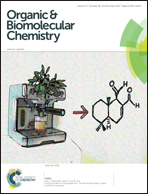An efficient and practical synthesis of [2-11C]indole via superfast nucleophilic [11C]cyanation and RANEY® Nickel catalyzed reductive cyclization†
Abstract
A rapid method for the synthesis of carbon-11 radiolabeled indole was developed using a sub-nanomolar quantity of no-carrier-added [11C]cyanide as radio-precursor. Based upon a reported synthesis of 2-(2-nitrophenyl)acetonitrile (2), a highly reactive substrate 2-nitrobenzyl bromide (1) was evaluated for nucleophilic [11C]cyanation. Additionally, related reaction conditions were explored with the goal of obtaining of highly reactive 2-(2-nitrophenyl)-[1-11C]acetonitrile ([11C]-2) while inhibiting its rapid conversion to 2,3-bis(2-nitrophenyl)-[1-11C]propanenitrile ([11C]-3). Next, a RANEY® Nickel catalyzed reductive cyclization method was utilized for synthesizing the desired [2-11C]indole with hydrazinium monoformate as the active reducing agent. Extensive and iterative screening of basicity, temperature and stoichiometry was required to overcome the large stoichiometry bias that favored 2-nitrobenzylbromide (1) over [11C]cyanide, which both caused further alkylation of the desired nitrile and poisoned the RANEY® Nickel catalyst. The result is an efficient two-step, streamlined method to reliably synthesize [2-11C]indole with an entire radiochemical yield of 21 ± 2.2% (n = 5, ranging from 18–24%). The radiochemical purity of the final product was >98% and specific activity was 176 ± 24.8 GBq μmol−1 (n = 5, ranging from 141–204 GBq μmol−1). The total radiosynthesis time including product purification by semi-preparative HPLC was 50–55 min from end of cyclotron bombardment.
![Graphical abstract: An efficient and practical synthesis of [2-11C]indole via superfast nucleophilic [11C]cyanation and RANEY® Nickel catalyzed reductive cyclization](/en/Image/Get?imageInfo.ImageType=GA&imageInfo.ImageIdentifier.ManuscriptID=C5OB01654A&imageInfo.ImageIdentifier.Year=2015)

 Please wait while we load your content...
Please wait while we load your content...